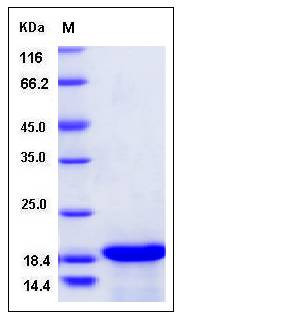Canine IL33 / Interleukin-33 / NF-HEV Protein
DVS27
- 100ug (NPP1769) Please inquiry
| Catalog Number | P70005-DNAE |
|---|---|
| Organism Species | Canine |
| Host | E. coli |
| Synonyms | DVS27 |
| Molecular Weight | The recombinant canine IL33 consists of 155 amino acids and has a calculated molecular mass of 17.8 kDa. In SDS-PAGE under reducing conditions, it migrates as an approximately 19KDa band. |
| predicted N | Met |
| SDS-PAGE |  |
| Purity | > 97 % as determined by SDS-PAGE |
| Protein Construction | A DNA sequence encoding the mature form of canine IL33 (O97863) (Ser 110-Ser 263) was expressed, with an initial Met at the N-terminus. |
| Bio-activity | 1. Measured by its binding ability in a functional ELISA. Immobilized Canine IL33 (P70005-DNAE) at 10 μg/ml (100 μl/well) can bind human IL1R4-Fc (P10105-H02H), The EC50 of human IL1R4-Fc (P10105-H02H) is 0.25-0.66 μg/ml. 2. Measured in a cell proliferation assay using D10.G4.1 mouse helper T cells costimulated with anti-CD3. The ED50 for this effect is typically 10-40 ng/mL. |
| Research Area | Cancer |Invasion microenvironment |Angiogenesis |Cytokines / Chemokines in Angiogenesis |Interleukins |
| Formulation | Lyophilized from sterile 5mM EDTA, PBS, pH 7.5 1. Normally 5 % - 8 % trehalose and mannitol are added as protectants before lyophilization. Specific concentrations are included in the hardcopy of COA. |
| Background | Interleukin 33 (IL-33), also known as DVS27 or NF-HEV (Nuclear Factor from High Endothelial enules), is a proinflammatory protein and a chromatin-associated cytokine of the IL-1 family with high sequence and structural similarity to IL-1 and IL-18. IL-33 protein is expressed highly and rather selectively by high endothelial venule endothelial cells (HEVECs) in human tonsils, Peyers's patches, and lymph nodes. IL-33 protein has transcriptional regulatory properties, and the researches suggested that IL-33 is a dual-function protein that might act both as a cytokine and as an intracellular nuclear factor. As a type 2 cytokines, IL-33 protein also play a pivotal role in helminthic infection and allergic disorders. |
| Reference |
